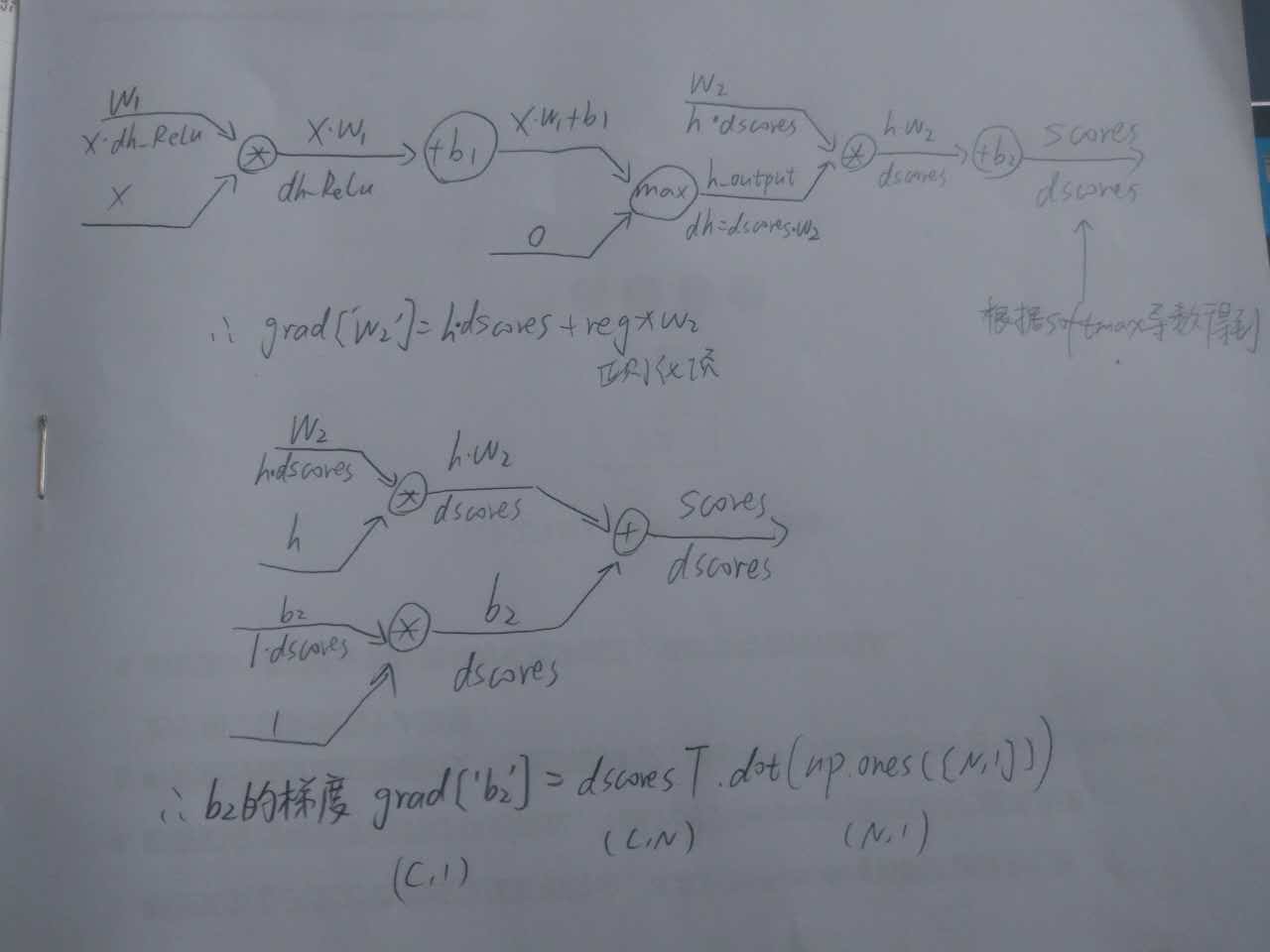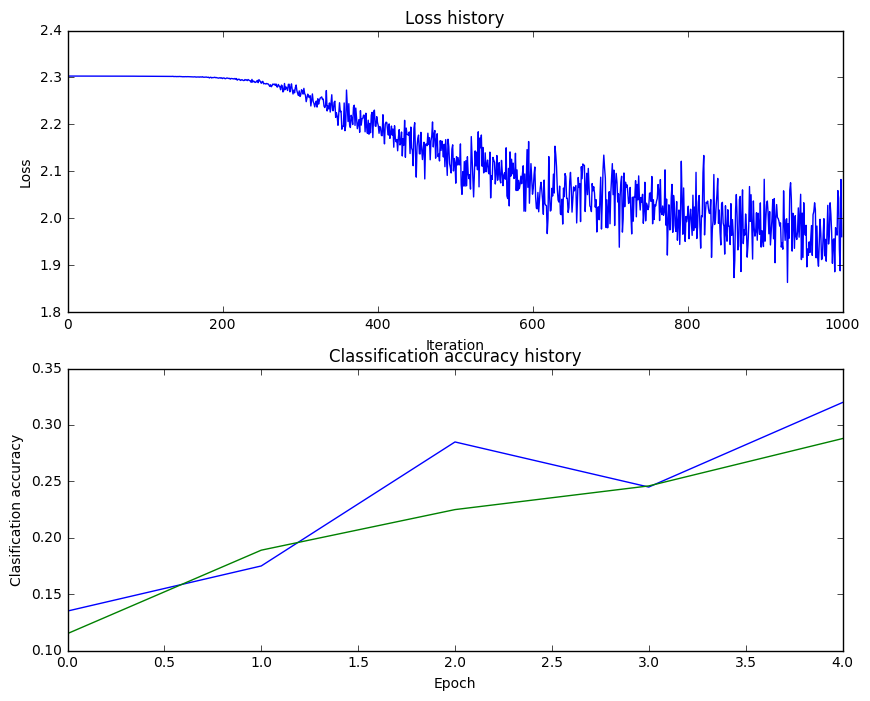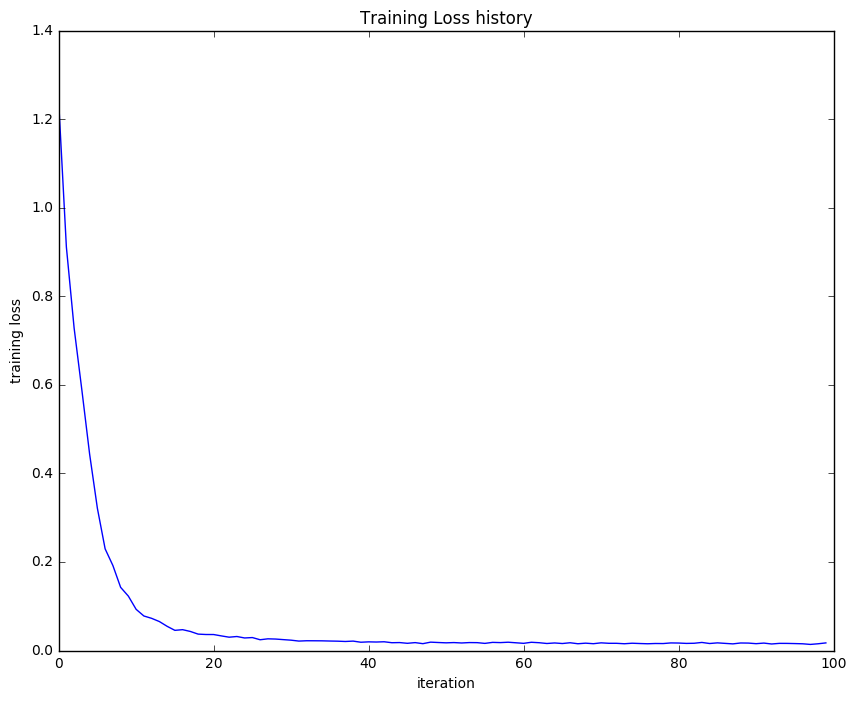cs231n的第一次作業2層神經網路
一個小測試,測試寫的函式對不對
首先是初始化
input_size = 4
hidden_size = 10
num_classes = 3
num_inputs = 5
def init_toy_model():
np.random.seed(0)
return TwoLayerNet(input_size, hidden_size, num_classes, std=1e-1)
def init_toy_data():
np.random.seed(1)
X = 10 * np.random.randn(num_inputs, input_size)
y = np.array([0 初始化
class TwoLayerNet(object):
def __init__(self, input_size, hidden_size, output_size, std=1e-4):
"""
Initialize the model. Weights are initialized to small random values and
biases are initialized to zero. Weights and biases are stored in the
variable self.params, which is a dictionary with the following keys:
W1: First layer weights; has shape (D, H)
b1: First layer biases; has shape (H,)
W2: Second layer weights; has shape (H, C)
b2: Second layer biases; has shape (C,)
Inputs:
- input_size: The dimension D of the input data.
- hidden_size: The number of neurons H in the hidden layer.
- output_size: The number of classes C.
""" 對於W1的維數,即將輸入樣本的個數每個分配一個權重,最後輸出相當於是hidden_size個分數,然後這些分數和啟用函式相比較,b1應該是比較的閾值吧(自己覺得),有些分數就不會起作用。這樣得到處理後的分數,在與W2相乘,與啟用函式相比較,可以看到,W2輸出是output_size,也就是說,輸出的分數和類別數一樣,即最終的分數。這裡初始化這四個引數的意思大概就是這樣子。
X的大小X.shape = (5, 4)
y的大小y.shape = (5, )
net.params[‘W1’].shape = (4, 10)
net.params[‘b1’].shape = (10, )
net.params[‘W2’].shape = (10, 3)
net.params[‘b2’].shape = (3, )
知道了維數關係,也就清楚了是 X*W 而不是 W*X,這個按實際去寫,不要硬記。
計算loss和grad
def loss(self, X, y=None, reg=0.0):
"""
Compute the loss and gradients for a two layer fully connected neural network.
Inputs:
- X: Input data of shape (N, D). Each X[i] is a training sample.
- y: Vector of training labels. y[i] is the label for X[i], and each y[i] is
an integer in the range 0 <= y[i] < C. This parameter is optional; if it
is not passed then we only return scores, and if it is passed then we
instead return the loss and gradients.
- reg: Regularization strength.
Returns:
If y is None, return a matrix scores of shape (N, C) where scores[i, c] is
the score for class c on input X[i].
If y is not None, instead return a tuple of:
- loss: Loss (data loss and regularization loss) for this batch of training
samples.
- grads: Dictionary mapping parameter names to gradients of those parameters
with respect to the loss function; has the same keys as self.params.
"""
# Unpack variables from the params dictionary
W1, b1 = self.params['W1'], self.params['b1']
W2, b2 = self.params['W2'], self.params['b2']
N, D = X.shape
# Compute the forward pass
scores = None
# Perform the forward pass, computing the class scores for the input.
# score.shape (N, C).
h_output = np.maximum(0, X.dot(W1) + b1) # (N,D) * (D,H) = (N,H)
scores = h_output.dot(W2) + b2
# If the targets are not given then jump out, we're done
if y is None:
return scores
# Compute the loss
loss = None
#Finish the forward pass, and compute the loss.
shift_scores = scores - np.max(scores, axis=1).reshape(-1, 1)
softmax_output = np.exp(shift_scores) / np.sum(np.exp(shift_scores), axis=1).reshape(-1, 1)
loss = -np.sum(np.log(softmax_output[range(N), list(y)]))
loss /= N
loss += 0.5 * reg * (np.sum(W1 * W1) + np.sum(W2 * W2))
# Backward pass: compute gradients
grads = {}
# Compute the backward pass, computing the derivatives of the weights #
# and biases. Store the results in the grads dictionary. For example, #
# grads['W1'] should store the gradient on W1, and be a matrix of same size #
dscores = softmax_output.copy()
dscores[range(N), list(y)] -= 1
dscores /= N
grads['W2'] = h_output.T.dot(dscores) + reg * W2
grads['b2'] = np.sum(dscores, axis=0)
dh = dscores.dot(W2.T)
dh_ReLu = (h_output > 0) * dh
grads['W1'] = X.T.dot(dh_ReLu) + reg * W1
grads['b1'] = np.sum(dh_ReLu, axis=0)
return loss, grads得分scores的計算,由之前權重W和輸入X的shape可知,
h_output = np.maximum(0, X.dot(W1) + b1) #第一層網路,啟用函式為max().
scores = h_output.dot(W2) + b2 #第二層網路,最後得到每個樣本的分數
損失loss的計算,這裡用的是softmax的損失函式,所以,要先減去最大值,歸一化,達到數值穩定。最後取了平均並且加了1/2的正則化項。
shift_scores = scores - np.max(scores, axis=1).reshape(-1, 1) #為了數值穩定
softmax_output = np.exp(shift_scores) / np.sum(np.exp(shift_scores), axis=1).reshape(-1, 1)#算了所有的 分數/sum
loss = -np.sum(np.log(softmax_output[range(N), list(y)])) #損失是正確的分類的分數/sum
loss /= N #compute average
loss += 0.5 * reg * (np.sum(W1 * W1) + np.sum(W2 * W2))#加正則項,這些可以參考之前的softmax
對於梯度的計算,對分類正確的Wyi分類器求導要多一個-Xi(具體求導可以參考上篇softmax部落格),所以這是下面第三行-1的原因。但是為什麼沒有乘以X呢(⊙o⊙)?,求解答
反向傳播計算線路參考圖

具體對應的程式碼
grads = {}
dscores = softmax_output.copy()
dscores[range(N), list(y)] -= 1
dscores /= N
grads['W2'] = h_output.T.dot(dscores) + reg * W2
grads['b2'] = np.sum(dscores, axis=0)
dh = dscores.dot(W2.T)
dh_ReLu = (h_output > 0) * dh
grads['W1'] = X.T.dot(dh_ReLu) + reg * W1
grads['b1'] = np.sum(dh_ReLu, axis=0)最後的測試結果,和提供的正確資料幾乎一致
W1 max relative error: 3.561318e-09
W2 max relative error: 3.440708e-09
b2 max relative error: 4.447625e-11
b1 max relative error: 2.738421e-09
訓練
def train(self, X, y, X_val, y_val,
learning_rate=1e-3, learning_rate_decay=0.95,
reg=1e-5, num_iters=100,
batch_size=200, verbose=False):
"""
Train this neural network using stochastic gradient descent.
Inputs:
- X: A numpy array of shape (N, D) giving training data.
- y: A numpy array f shape (N,) giving training labels; y[i] = c means that
X[i] has label c, where 0 <= c < C.
- X_val: A numpy array of shape (N_val, D) giving validation data.
- y_val: A numpy array of shape (N_val,) giving validation labels.
- learning_rate: Scalar giving learning rate for optimization.
- learning_rate_decay: Scalar giving factor used to decay the learning rate
after each epoch.
- reg: Scalar giving regularization strength.
- num_iters: Number of steps to take when optimizing.
- batch_size: Number of training examples to use per step.
- verbose: boolean; if true print progress during optimization.
"""
num_train = X.shape[0]
iterations_per_epoch = max(num_train / batch_size, 1)
# Use SGD to optimize the parameters in self.model
loss_history = []
train_acc_history = []
val_acc_history = []
for it in xrange(num_iters):
X_batch = None
y_batch = None
# Create a random minibatch of training data and labels, storing #
# them in X_batch and y_batch respectively. #
idx = np.random.choice(num_train, batch_size, replace=True)
X_batch = X[idx]
y_batch = y[idx]
# Compute loss and gradients using the current minibatch
loss, grads = self.loss(X_batch, y=y_batch, reg=reg)
loss_history.append(loss)
# Use the gradients in the grads dictionary to update the #
# parameters of the network (stored in the dictionary self.params) #
# using stochastic gradient descent. You'll need to use the gradients #
# stored in the grads dictionary defined above. #
self.params['W2'] += - learning_rate * grads['W2']
self.params['b2'] += - learning_rate * grads['b2']
self.params['W1'] += - learning_rate * grads['W1']
self.params['b1'] += - learning_rate * grads['b1']
if verbose and it % 100 == 0:
print 'iteration %d / %d: loss %f' % (it, num_iters, loss)
# Every epoch, check train and val accuracy and decay learning rate.
if it % iterations_per_epoch == 0:
# Check accuracy
train_acc = (self.predict(X_batch) == y_batch).mean()
val_acc = (self.predict(X_val) == y_val).mean()
train_acc_history.append(train_acc)
val_acc_history.append(val_acc)
# Decay learning rate
learning_rate *= learning_rate_decay
return {
'loss_history': loss_history,
'train_acc_history': train_acc_history,
'val_acc_history': val_acc_history,
}
訓練基本和之前的softmax和svm一樣,取小樣本,計算損失和梯度,用SGD更新W和b(在svm中,W增加了一列,放b)。
最後的幾句程式碼,計算了預測準確率,並且學習率在不停的減小。
畫出loss_history與迭代次數的曲線,可以看到20次後loss基本不變。
開始用CIFAR10資料實戰
測試小例子很成功呀,是時候開始用CIFAR10資料來實驗。
input_size = 32 * 32 * 3
hidden_size = 50
num_classes = 10
net = TwoLayerNet(input_size, hidden_size, num_classes)
# Train the network
stats = net.train(X_train, y_train, X_val, y_val,
num_iters=1000, batch_size=200,
learning_rate=1e-4, learning_rate_decay=0.95,
reg=0.5, verbose=True)
# Predict on the validation set
val_acc = (net.predict(X_val) == y_val).mean()
print 'Validation accuracy: ', val_acc輸出結果
iteration 0 / 1000: loss 2.302954
iteration 100 / 1000: loss 2.302550
iteration 200 / 1000: loss 2.297648
iteration 300 / 1000: loss 2.259602
iteration 400 / 1000: loss 2.204170
iteration 500 / 1000: loss 2.118565
iteration 600 / 1000: loss 2.051535
iteration 700 / 1000: loss 1.988466
iteration 800 / 1000: loss 2.006591
iteration 900 / 1000: loss 1.951473
Validation accuracy: 0.287
訓練集的準確率只有28.7%,不太理想呀

藍線為 train_acc_history,綠線為 val_acc_history
hidden_size = [75, 100, 125]
learning_rates = np.array([0.7, 0.8, 0.9, 1, 1.1])*1e-3
regularization_strengths = [0.75, 1, 1.25]
hs 100 lr 1.100000e-03 reg 7.500000e-01 val accuracy: 0.502000
best validation accuracy achieved during cross-validation: 0.502000
用了三層for迴圈,硬生生找了三個較好的引數,準確率達到了50.2%
hint裡提示用PCA降維,adding dropout, 或者adding features to the solver來到達更好的效果,這些先放著以後試吧(加粗防忘記)
參考
(對了如果想儲存網頁內容,可以用chrome瀏覽器,右鍵列印,儲存為pdf,可以選擇儲存的頁數,再打印出來看,對著電腦看眼睛吃不消了)

